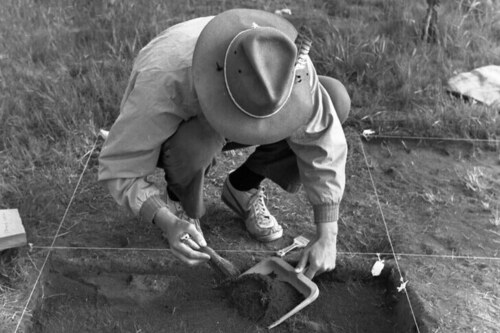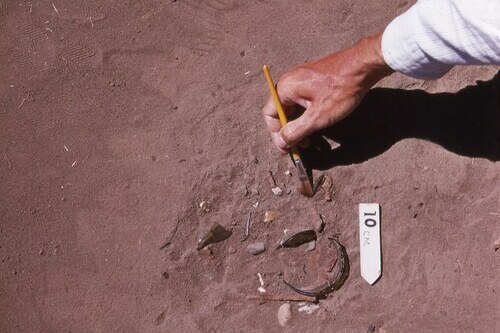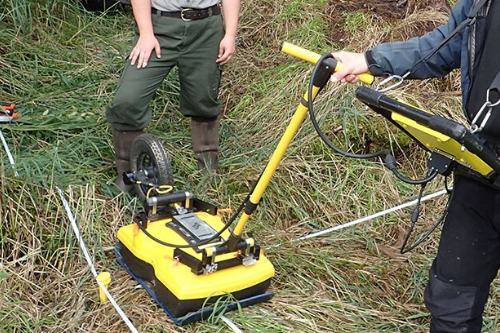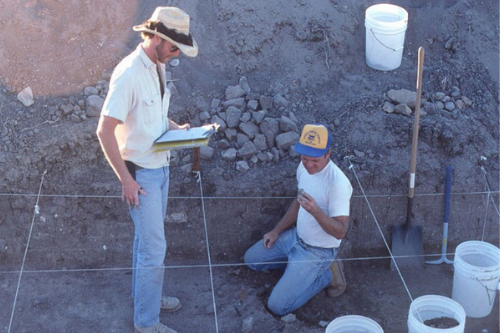
Dig Deeper Conclusion
Dig Deeper is a monthly blog focusing on the basics of archaeology by taking a closer look at the exhibition Archaeology 101, which is currently featured at the Center.
Over the past year, we have explored the Center’s exhibit Archaeology 101 and dug deeper into some of the concepts and themes that revolve around the field of archaeology. Let’s refresh!
Part 1 – What is Archaeology?
Archaeology is the study of human history and prehistory through the excavation of sites and the analysis of artifacts and other physical remains. It is important because the information uncovered may help make decisions about the future and widen our understanding of human cultures, technology, and societies throughout time.
There are more than 30,000 recorded sites in San Diego County. So far, these sites have indicated more than 10,000 years of human history in the region. With the help of regulations enacted to protect natural and cultural resources, sites and artifacts have been monitored and protected for future generations to come. Learn more about NAGPRA, CEQA, and ARPA.
Part 2 – What Tools Do Archaeologists Use?
An archaeologist’s tool kit has objects as simple as a toothbrush and can be as sophisticated as a total station theodolite, an electronic surveying tool used to measure distance, slope, angles, and elevation of features at an archaeological site. The tools an archaeologist will use depends on the size, location, and type of soil at each site. At any excavation, the goal is precision when uncovering artifacts and ecofacts. The one tool almost all archaeologists use is a pointing trowel. This type of trowel is used to carefully scrape dirt back in a controlled way so not to disturb anything but the dirt.
Part 3 – How Do Archaeologists Know Where to Dig?
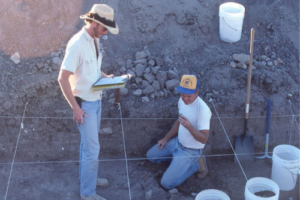
There are many ways that archaeologists locate sites. Historic records, including photographs and maps, may tell archaeologists where activity took place in the past. The site is visually surveyed before any excavating begins by walking in grids and scanning the ground for artifacts. Even the soil leaves clues! Midden soil – midden is a layer of sediment containing organic materials resulting from past human occupation – can be an indicator because the soil becomes darker and greasy looking from the organic materials, ash, and moisture left behind by humans. Geophysical equipment (resistivity meters, magnetometers or GPR, and GPS) help archaeologists look for features without disturbing a site.
Part 4 – How Do Archaeologists Know Who Made the Artifacts at a Site?
One of the most important concepts to remember about archaeology is CONTEXT. The relationship between artifacts, time, frequency, and methodology can yield important information about the site as a whole. If an artifact is picked up or removed from where it was found before all of this information was recorded, it loses context and therefor displaces the artifact from its culture and history. An assemblage refers to certain artifacts found frequently together from the same time period and generally can be associated with a specific culture. Types of tools found help indicate what people were doing during different periods of time.
Part 5 – How Are Stone Tools Made?
There are generally two different types of stone tools found throughout the world. The Stone Age lasted for over 3 million years until humans began making metal implements to replace them. In the Americas, the Stone Age ended when Europeans colonized Native American lands. The first type of stone tool is called chipped stone. Chipped stone tools are made by carefully chipping away from the stone to achieve the desired shape. These types of tools were helpful with hunting, building, and food preparation because they could be made with very sharp edges or points. The other type of stone tool is called ground stone. These tools are made by grinding, shaping, and smoothing the stone. Ground stone tools helped to grind food and could also be used as weapons, like axes or clubs.
Part 6 – What Are All of These Stone Chips?
Debitage are the chips produced during stone tool production. Even in the absence of tools, debitage can indicate a lot about a site. For example, the size and type of debitage found can indicate the method used to make the tool.
Part 7 – How Old Is It? Absolute Dating
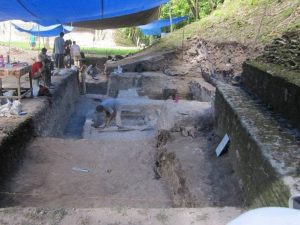
Dating is very important in the field of archaeology. There are two overarching methods used to date sites and artifacts. Absolute dating allows archaeologists to arrive at a definite date while relative dating allows them to estimate a date based upon surroundings. Absolute dating can be used when artifacts are date stamped, like coins or a newspaper clipping. Another form of absolute dating is Carbon-14 dating. Organic artifacts such as bone or shell absorb a certain amount of carbon in their lifetime. When organic materials die, the number of carbon-14 begins to decline. The rate of decay can measure the remaining Carbon-14 giving archaeologists a more exact date.
Part 8 – How Old Is It? Relative Dating
Relative dating is used by looking at artifacts, such as the date stamped coin, found in the same strata, or layer of soil and debris at an archaeological site. This indicates that the artifacts were buried at the same time and thus come from the same time period.
Conclusion
This concludes the Dig Deeper blog. There is much more to learn about the world of archaeology – continue to dig deeper. We hope you learned a lot and can visit the exhibit Archaeology 101 in person soon.
As things begin to reopen in San Diego County, the SDAC is taking the proper steps to welcome you back. We look forward to seeing you again soon.
By Jessica McPheters, Collections Manager


